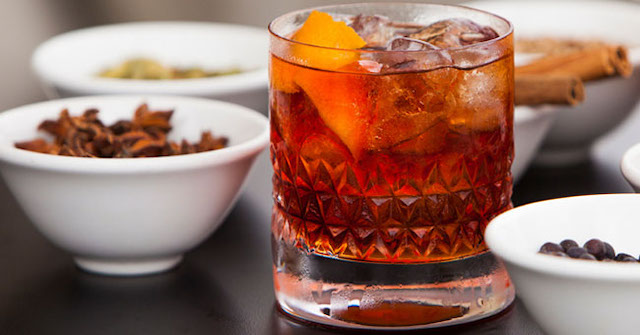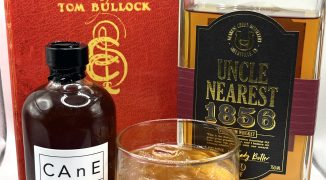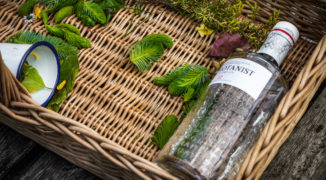At first, mixing red wine and hard alcohol might not seem like the best idea. At best, it’s a souped-up sangria. At worst, it’s a dreadful hangover, the high school kind caused by drinking half empty bottles of whatever’s leftover in your parent’s liquor cabinet. But for the enterprising bartender willing to experiment, red wine can be a delicious and secretly versatile addition to cocktails, enlivening your bar menu with new flavors, aromas, and colors.
There are two directions you can go in when crafting a wine cocktail: one where wine is the base ingredient, or one where it’s in a supporting role. A predominantly wine-based cocktail has its advantages — for one, it’s an easy, familiar way to build a lower-alcohol drink.
But it’s when wine is used as a cocktail ingredient that the possibilities really start to open up. The incredible variety of red wines means that you’re only limited by the pairings you can come up with: almost any flavor you want to complement can be highlighted by wine. Want a fruity, jammy flavor? Want to incorporate a bolder tannic taste? Want to add acid in a way that’s not citrus? Bring in the wine.
That adaptability means red wine works with spirits across the board. At last year’s Tales of the Cocktail, Washington winery Ste. Michelle Wine Estates held a contest called “Shaking The Vine,” where bartenders came up with cocktail incorporating their company’s wines, including a tempranillo blend. There were over 300 entries, mixing red wine with everything from gin to bourbon.
There’s only one major rule when it comes to building cocktails around red wine, said Ryan Pennington, the winery’s Director of Communications: “Try to see the characteristics of the wine as complementary to the spirits, and use it less with spirits that have similar characteristics,” he said. “If a red wine has a smokiness from the oak, [like] barrel aging, I wouldn’t mix that with a mezcal. It’s too much. But beyond that, there are really endless combinations of how you can use red wine in a cocktail.”
H. Joseph Ehrmann, who owns San Francisco’s Elixir, first discovered wine cocktails in 2008, after a winery commissioned him to build cocktails with their varietals. He approached the task like he did every new ingredient — isolating the flavors and aromas of the ingredient, and testing what cocktail components paired well with it — and a whole new world of cocktails opened up for him and his bar. Since then, he’s featured several wine cocktails on the menu, and has used wine in every form he can: cooked down as syrup, an infusion in the style of a vermouth, and even atomized to create a vodka, Cabernet Sauvignon, and lemon sparkling cocktail.
The teeth-staining properties of wine also make it an ideal way to add some color to a clear cocktail. Even just a small amount can color a drink: Ehrmann recommends it as a substitute for a claret atop a whiskey sour.
“Ever since that first time playing with it, I consider it as viable an ingredient as an herb, fruit or liqueur,” Ehrmann said. His one rule? “Use good wine. If you’re using wine that’s not fresh and of decent quality, you’re downplaying the quality of your end result.”
Wine-based drinks are also a natural fit for holiday menus. From Sweden’s glögg to Turkey’s sicak şarap, people associate batches of wine simmered with warming spices with cozy winter nights. And if you’re going to make a traditional mulled wine, get the most mileage out of it that you can: Ehrmann suggests adding small amounts of mulled wine to cocktails to add a wintery kick to any drink.
But don’t think that you can’t put a red wine cocktail on the menu year round. That atomized wine cocktail? Ehrmann came up with it while developing ideas for a Fourth of July barbeque. “It’s all in the marketing,” he said with a laugh.
That kind of creativity has been a boon for wineries like Chateau Ste. Michelle, but they weren’t always convinced that putting their wine in cocktails was a good idea, Pennington said. “To be honest, one of the other things we wrestled with in the beginning was, would it be seen as degrading to the wine?”
But the success of Shaking the Vine — and the hundreds of excited entries — convinced them otherwise, and they now serve wine-based cocktails at their winemaker dinners.
“People are paying so much more attention to the ingredients in their drinks, where they’re coming from, who’s making it, that there’s no negative connotation to having a wine in a cocktail,” he said.
“If anything, it helps elevate the wine as another artisan, craft ingredient that bartenders can use to make a special drink. It’s an area in the cocktail world that’s still up and coming, and I think more and more places are going to see wine-based cocktails as deserving of a permanent place on their menu.”





